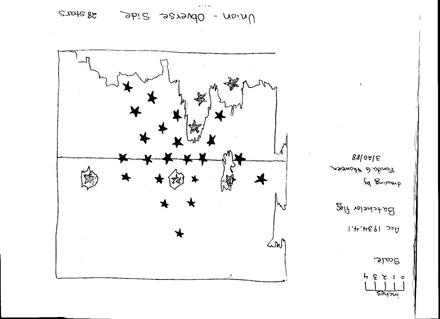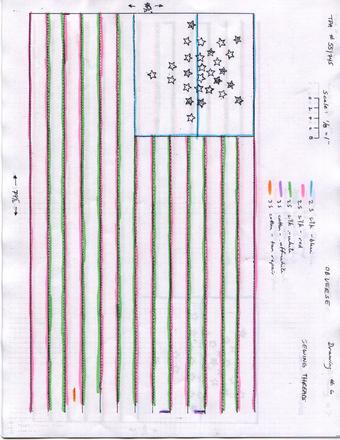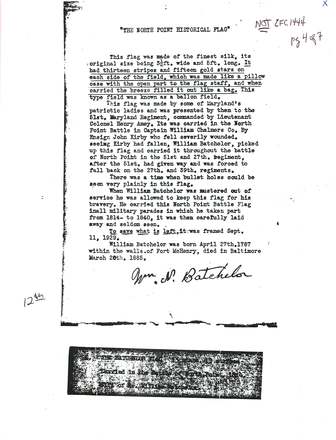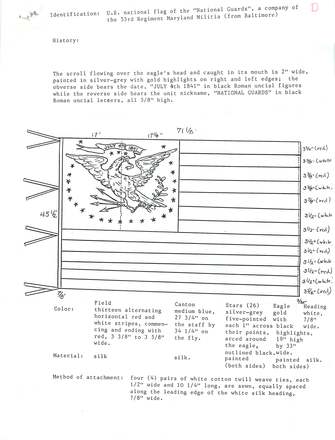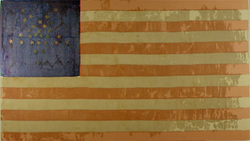

Book Photo

Obverse

Label Detail

Stripes Detail

Frame Detail

Stripes Detail - 2

Stripes Detail - 3

Canton Center Detail

Stripes Detail - 3

Upper Fly Detail

Canton

Obverse - 2

Obverse Before Conservation

Reverse Before Conservation

Reverse - 2 Before Conservation

Reverse Canton Before Conservation

Reverse Canton - 2 Before Conservation

Backing

ZFC1444 at SSBFH before conservation

ZFC1444 at SSBFH before conservation
U.S. 28 Star National Color, 4th Louisiana Militia
Sub-collection: Star Spangled Banner Flag HouseU.S. 28 Star "Grand Luminary" National Color, 1845 - 1846, Louisiana Militia, Mexican-American War, SSBFH.
This period example 28 star United States flag was made to indicate the admission of Texas as the 28th state on December 29, 1845; and would remain accurate until the admission of Iowa on December 28 1846, a period of 364 days; correspondingly 28 star flags are quite rare. This U.S. National Flag of 28 Stars is made in a "Grand Luminary" star pattern; and contains the national colors of the 4th Louisiana Militia, raised in1846, but disband before seeing any combat.
Prior to The Mexican American War in 1846 The US national flag was not taken into land battles. Only state, militia or unit designating flags such as regimentals were taken into battle by the army. The Mexican American War was the first and the Spanish American/Philippine Insurrection conflicts were the last in which the United States Army used the national flag in the "field" or any battle. Since the revolution the Continental and subsequent US Navy has used the national flag as an ensign on military and government ships.
The 28 gold painted stars on this flag represent a design whose popularity spanned nearly the entire 19th century. The Grand Luminary star pattern, (sometimes called great-star or great flower) represented the idea of the national motto E Pluribus Unum "Out of many, one". Each star is isolated and individual, nevertheless all work together to create a unified pattern and a Union of states.
Exhibition History:
First Presidio Exhibit
(ZFC1444)
Grand Luminary Twenty-Eight-Star United States National Color
Second Presidio Exhibit, 2003 Gallery II
(ZFC1444)
28-Star Grand Luminary United States National Color
Publication History:
Madaus, Howard M., Dr, Whitney Smith, The American Flag: Two Centuries of Concord and Conflict. Santa Cruz: VZ Publications, 2006, pp. 44-45.
Busico, Michalene, "To Have or to Hold." Collection, Published by Robb Report, June 2014, p.15.
Provenance:
• Handmade in and for the City of New Orleans, 1846.
• Gifted by City of New Orleans to Colonel (later General) Horatio Davis, The Montezuma Regiment, ( 4th Louisiana Volunteer Militia) , 1846.
• By descent in the Davis family until 1962.
• Gifted to the Star Spangled Banner Flag House and Museum (SSBFH) by Davis descendant Mrs. Frank M. Rogers in 1962.
• Temporarily returned to Mrs. Rogers in 1965.
• Permanently returned to SSBFH, 1965.
• Purchased by private treaty by the Zaricor Flag Collection from the Star-Spangled Banner Flag House Collection of Baltimore, MD, in 1996.
Sources:
Madaus, Howard M.- Whitney Smith, The American Flag: Two Centuries of Concord and Conflict, VZ Publications, Santa Cruz, 2006.
Mastai, Boleslaw and Marie-Louise D'Otrange, The Stars and The Stripes: The American Flag as Art and as History from the Birth of the republic to the Present, Knopf, New York, 1973.
Cooper, Grace Rogers, Thirteen-Star Flags: Keys to Identification, Smithsonian Institution Press, City of Washington, 1973.
Samuel Chester Reid, Wikipedia, 24 October 2011, from: http://en.wikipedia.org/wiki/Samuel_Chester_Reid
Great Star Flags (U.S.), Flags of the World, 25 October 2011, from: http://www.crwflags.com/fotw/flags/us-gstar.html
Martucci, David, Great Star Flags, US Flags: Part 5, 25 October
Image Credits:
Zaricor Flag Collection
CSG
MLC
MLF
MLNC
Hoist & Fly | |
|---|---|
| Width of Hoist | 80 |
| Length of Fly | 46.5 |
Union/Canton | |
|---|---|
| Width of Union/Canton | 25 |
| Length of Union/Canton | 25 |
Stars | |
|---|---|
| Comments on Star Measurements | Stars are in gold in a grand Luminary Pattern |
| Size of Stars | 1.5 |
Stripes | |
|---|---|
| Width of 1st Stripe | 3.5 |
| Width of 3rd Stripe | 3.5 |
| Width of 8th Stripe | 3.75 |
| Width of Last Stripe | 3 |
Frame | |
|---|---|
| Is it framed? | yes |
| Frame Height | 52.5 |
| Frame Length | 86 |
| Comments on Frame | Framed (outside dimensions 52.5 x 86). |
Stars | |
|---|---|
| Number of Stars | 28 |
| Are there stars on obverse? | yes |
| Are there stars on reverse? | no |
Stripes | |
|---|---|
| Number of Stripes | 13 |
| Color of Top Stripe | Red |
| Color of Bottom Stripe | Red |
| Has a Blood Stripe? | no |
Nationality | |
|---|---|
| Nation Represented | United States |
Fabric | |
|---|---|
| Fabric | Silk |
Attachment | |
|---|---|
| Comments on Method of Attachmen | No hoist |
Condition | |
|---|---|
| Condition | Fair |
| Damage | Underwent Textile Preservation by Fonda Thompson. Very bad |
| Displayable | yes |
Date | |
|---|---|
| Date | 1845 |
Exhibits | |
|---|---|
| Exhibition Copy | Exhibition History First Presidio Exhibit (ZFC1444) GRAND LUMINARY TWENTY-EIGHT-STAR UNITED STATES NATIONAL COLOR Date: 1846 Medium: Silk with painted stars; all hand sewn Comment: This United States National Color was prepared by the ladies of New Orleans in 1846 in appreciation for what the 4th Regiment Louisiana Militia did during the Battle of New Orleans in 1814. The Regiment had been organized for service in Mexico, but it was disbanded before it saw any combat, and the commanding colonel took the flag home with him when his unit was mustered out. As was popular during the era, the twenty-eight-stars of this flag are painted in gold paint on the canton in the form of a single large star a grand luminary. The ladies who prepared it ignored or were unaware of the official regulations for the preparation of Army Colors, as it is smaller than the nearly six foot square size required by regulations. Provenance: Acquired by the Zaricor Flag Collection (ZFC1444) in 1997 from the Star-Spangled Banner Flag House Collection of Baltimore, MD. Second Presidio Exhibit, 2003 Gallery II (ZFC1444) 28-Star Grand Luminary United States National Color Date: 1846 28 Stars: July 4, 1846-July 3, 1847 (Texas statehood December 29, 1845) Medium: Silk with painted stars; hand-sewn Comment: This United States national color was prepared by the ladies of New Orleans in 1846 in appreciation for what the 4th Regiment Louisiana Militia had done during the Battle of New Orleans in 1814. The regiment was organized for service in Mexico during the 1846-1848 war, but it was disbanded before seeing any combat. As often happened in that era, the commanding colonel simply took the flag home with him when his unit was mustered out. The 28 stars of this flag are painted in gold, as was common then. They form a single large star or Grand Luminary in the canton of the flag. The women who prepared it ignoredor more likely were unaware of the official regulations for the preparation of Army colors, this flag being smaller than the nearly six-foot-square size required by those specifications. Provenance: Acquired by the Zaricor Flag Collection (ZFC1444) in 1997 from the Star-Spangled Banner Flag House Collection of Baltimore, MD. |
Publications | |
|---|---|
| Publication Copy | Madaus, Howard M., Dr, Whitney Smith, The American Flag: Two Centuries of Concord and Conflict. Santa Cruz: VZ Publications, 2006, pp. 44-45. 28-Star Grand Luminary United States National Color. This United States national color was prepared by the ladies of New Orleans in May of 1846 for the 4th Regiment Louisiana Militia. The regiment, known as the Montezuma Regiment, was organized for service in Mexico during 1846, but it was disbanded after only six months before seeing any combat. As often happened in that era, the unit commander, Colonel Horatio Davis, simply took the flag home with him when his unit was mustered out of service. Colonel (later General) Horatio Davis was born on the ship Guerrire, and his father, Samuel B. Davis, had been a War of 1812 Old Defender who had participated in the defense of Baltimore in 1814. The 28 stars of this flag are painted in gold, as was common then. They form a single large star or Grand Luminary in the canton of the flag. The women who prepared it ignored or more likely were unaware ofthe official regulations for the preparation of Army colors, this flag being smaller than the nearly six-foot-square size required by those specifications. This fragile silk flag is devoid of color and severely damaged on the fly and bottom white stripe. In the process of conserving the flag, they have been encapsulated to represent the flags original appearance. This flag was made for service in the Mexican- American War, during the presidency of James K. Polk. The first U.S. postage stamps were issued in 1846 and the same year the Oregon Treaty drew a border between British and American claims to territory in the Northwest. Date: 1846 Size: 46.5" hoist x 80" fly 28 Stars: July 4, 1846 July 3, 1847 (Texas statehood December 29, 1845) Medium: Silk with painted stars; hand-sewn Provenance: Acquired by the Zaricor Flag Collection in 1997 from the Star-Spangled Banner Flag House Collection of Baltimore, MD. ZFC1444 |
| Publication Images | |

